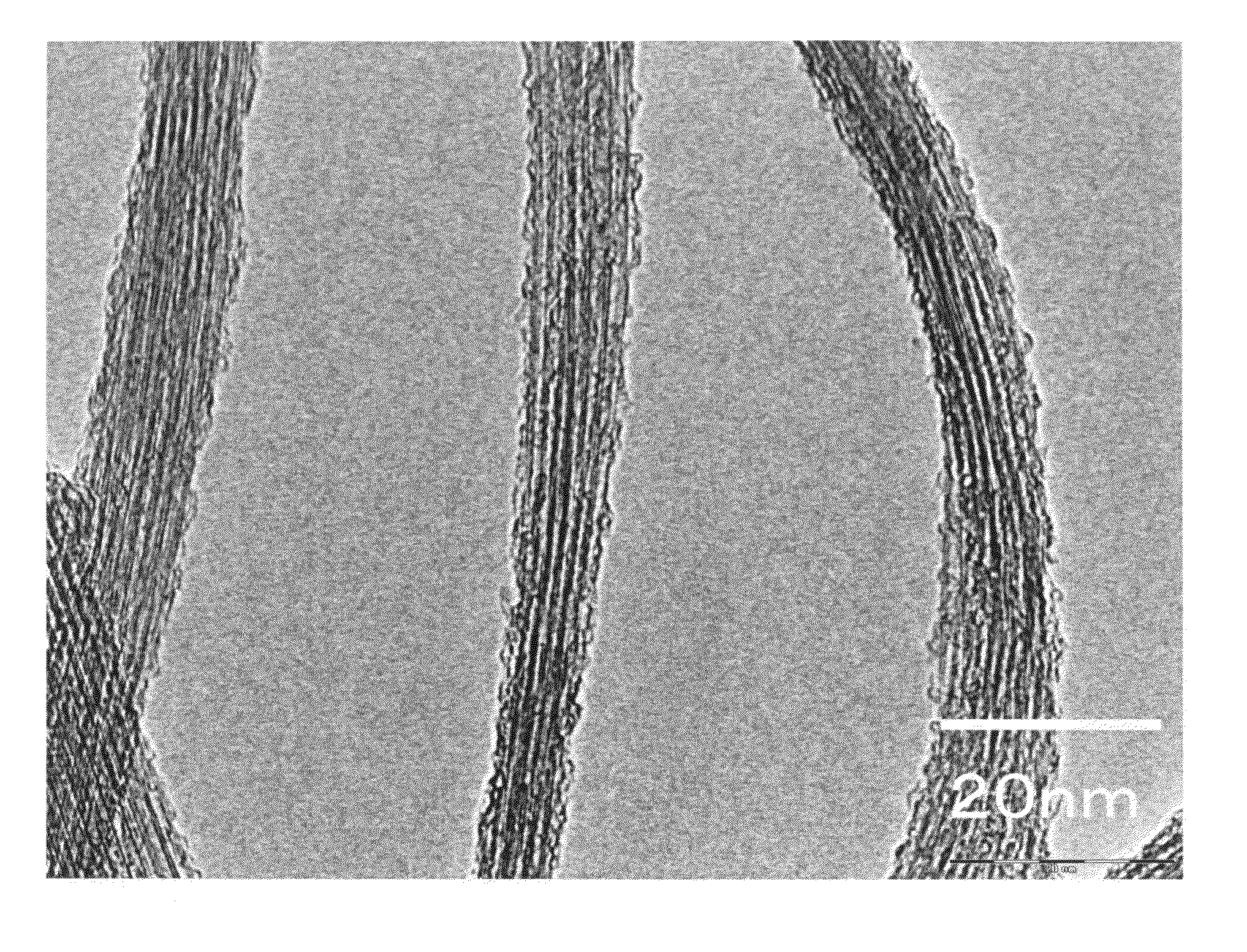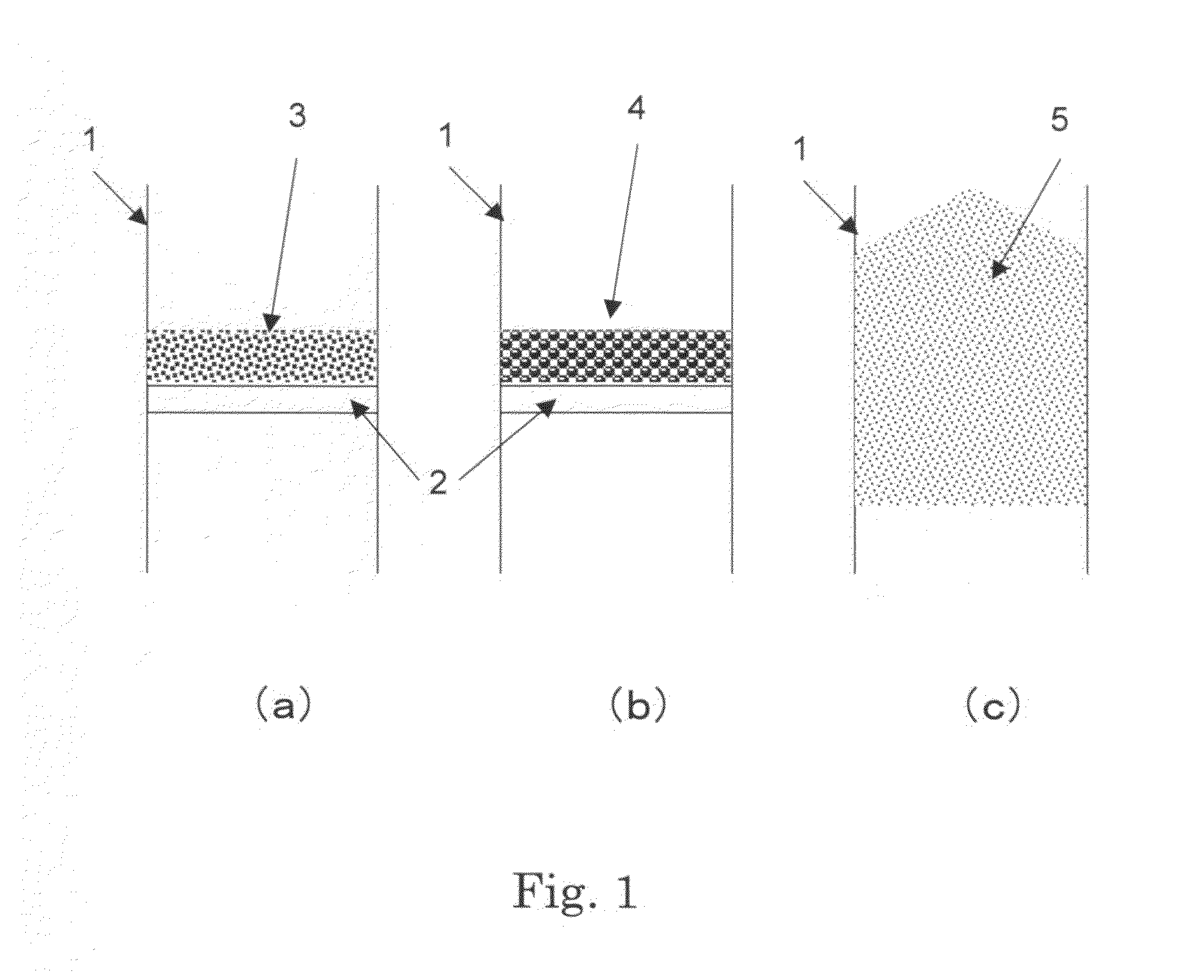Carbon nanotube assembly and electrically conductive film
a carbon nanotube and electrically conductive film technology, applied in the direction of electrically conductive paints, conductors, non-metal conductors, etc., can solve the problems of exhibiting a nano-effect, difficult to develop various applications, dispersion in resins, etc., to achieve excellent transparency and electrical conductivity, good dispersibility, and high conductivity
- Summary
- Abstract
- Description
- Claims
- Application Information
AI Technical Summary
Benefits of technology
Problems solved by technology
Method used
Image
Examples
example 1
Supporting Metal Salt on Light Magnesia
[0149]5 g of iron ammonium citrate (manufactured by Wako Pure Chemical Industries Ltd.) was dissolved in 250 mL of methanol (manufactured by Kanto Chemical Co., Ltd.). To this solution, 50 g of light magnesia (manufactured by Wako Pure Chemical Industries Ltd., bulk density was 0.16 g / mL) was added, treated for 60 minutes by an ultrasonic cleaner, and methanol was removed by drying while stirring at 40° C. to 60° C., thereby to obtain a solid catalyst that metal salt was supported on light magnesia powder.
[0150](Synthesis of Double-Walled Carbon Nanotube)
[0151]Carbon nanotubes were synthesized by a vertical reactor shown in FIG. 2.
[0152]A reactor 100 is a cylindrical quartz tube of 32 mm in inner diameter and 1200 mm in length. A quartz sintered plate 101 is equipped in the center part, an inert gas and raw gas supply line 104 is equipped in the bottom part of the quartz tube, and in the upper part thereof, a waste gas line 105, a sealed cataly...
example 2
Supporting Metal Salt on Light Magnesia
[0166]A solid catalyst was obtained by doing in the same manner as Example 1.
[0167](Synthesis of Double-Walled Carbon Nanotube)
[0168]On nonwoven fabric made of silica / alumina, 8.0 g of the solid catalyst prepared above was placed, and heated at 870° C. A quartz tube of 250 mm inner diameter equipped in a vertical direction inside a vertical reactor was introduced to the central part of a reaction tube of the vertical reactor equipped in the vertical direction of the reactor. Argon gas was supplied at 50 L / min for 5 minutes toward the upper direction of the quartz tube reactor from the bottom of the quartz tube reactor, flowed through a catalyst layer, then, methane gas and argon gas were introduced at 130 mL / min and 3.0 L / min, respectively for 30 minutes and flowed so as to be passed through the catalyst layer, both were contacted and reacted. Introduction of methane gas was stopped, after argon gas alone was flowed at 50 L / min for one minute, ...
example 3
Production of Field Electron Emission Source
[0179]In a beaker of 100 mL, 50 mg of the carbon nanotubes obtained in Example 1 that the catalyst was removed, and 100 mL of acetone were put, and irradiated by ultrasonic waves for 30 minutes, obtaining the dispersion liquid. The present dispersion liquid was put in a beaker in which a copper plate was put, left still for acetone to evaporate naturally, thereby to obtain a copper plate that carbon nanotubes were deposited on the surface.
[0180](Evaluation of Filed Electron Emission Capability)
[0181]The copper plate obtained can be used as a cathode of a field emission device. The copper plate that carbon nanotubes were deposited on the surface is used as a cathode electrode, and other copper plate is disposed as an anode electrode facing the above-described cathode electrode. This diode structural object is introduced to a chamber for evaluation, and field electron emission capability can be evaluated. The carbon nanotubes obtained in the...
PUM
 Login to View More
Login to View More Abstract
Description
Claims
Application Information
 Login to View More
Login to View More - R&D
- Intellectual Property
- Life Sciences
- Materials
- Tech Scout
- Unparalleled Data Quality
- Higher Quality Content
- 60% Fewer Hallucinations
Browse by: Latest US Patents, China's latest patents, Technical Efficacy Thesaurus, Application Domain, Technology Topic, Popular Technical Reports.
© 2025 PatSnap. All rights reserved.Legal|Privacy policy|Modern Slavery Act Transparency Statement|Sitemap|About US| Contact US: help@patsnap.com



